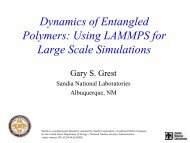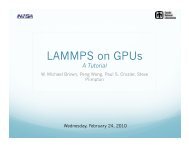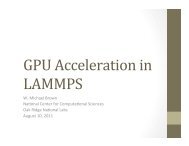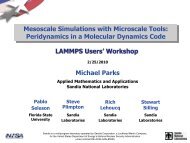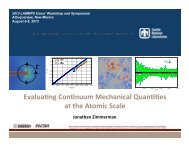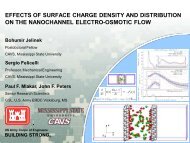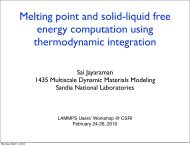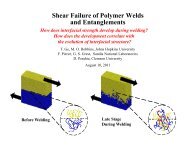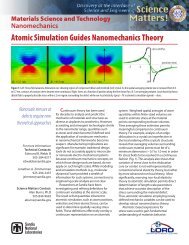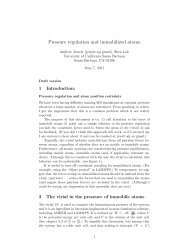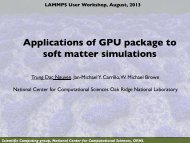this user's guide - Lammps
this user's guide - Lammps
this user's guide - Lammps
Create successful ePaper yourself
Turn your PDF publications into a flip-book with our unique Google optimized e-Paper software.
The implementation of Smooth Particle Hydrodynamics in<br />
LAMMPS.<br />
A <strong>guide</strong> to the SPH-USER package.<br />
Georg C. Ganzenmüller ∗ and Martin O. Steinhauser<br />
Fraunhofer Ernst-Mach Institut für Hochgeschwindigkeitsdynamik<br />
Freiburg, Germany<br />
Paul Van Liedekerke<br />
Faculty of Bio-Engineering, MEBIOS Division<br />
Katholieke Universtiteit Leuven<br />
Leuven, Belgium<br />
July 17, 2011<br />
∗ georg.ganzenmueller@emi.fraunhofer.de<br />
1
SPH-USER Documentation Contents 2<br />
Contents<br />
1. Introduction 3<br />
1.1. Quick Start Guide<br />
2. Getting Started 4<br />
2.1. Building the SPH module within LAMMPS<br />
2.2. Running SPH simulations with LAMMPS<br />
3. SPH Theory 5<br />
3.1. SPH approximation of the local density<br />
3.2. SPH approximation of the Navier-Stokes equation of motion<br />
3.3. SPH approximation of the Navier-Stokes continuity equation<br />
3.4. SPH approximation of the Navier-Stokes energy equation<br />
3.5. SPH artificial viscosity<br />
3.6. SPH laminar flow viscosity<br />
4. Implementation of SPH in LAMMPS 9<br />
4.1. Data structure<br />
4.2. Time stepping<br />
4.3. Local density calculation<br />
4.4. Equation of State<br />
4.5. Heat conduction<br />
4.6. Boundary conditions<br />
4.7. Accessing SPH variables for initialisation and output<br />
5. Validation tests 13<br />
5.1. Heat conduction<br />
5.2. Shock wave structure<br />
5.3. Collapse of a water column<br />
5.4. Shear cavity flow
SPH-USER Documentation Introduction 3<br />
1. Introduction<br />
This document describes the implementation of the Smooth Particle Hydrodynamics (SPH)<br />
method within the Large-scale Atomic/Molecular Massively Parallel Simulator (LAMMPS).<br />
LAMMPS is a particle simulation code, developed and maintained at Sandia National Laboratories,<br />
USA. While is primarily aimed at Molecular Dynamics simulations of atomistic systems,<br />
it provides a general, fully parallelized framework for particle simulations governed by Newton’s<br />
equations of motion.<br />
SPH is a continuum method, which does not require a predefined grid to evaluate the associated<br />
partial differential field equations of continuum mechanics. Instead, SPH discretises the<br />
mass distribution field into point masses which move with the material, according to Newtons<br />
equations of motion. The positions of the point masses serve as integration nodes for the field<br />
equations of continuum mechanics. The required variable fields are constructed on-the-fly using<br />
interpolation kernels, which are centred at the point masses. Due to its particle nature, SPH is<br />
directly compatible with the existing code architecture and data structures present in LAMMPS.<br />
1.1. Quick Start Guide<br />
For those who hate reading users’ <strong>guide</strong>s, please try the following:<br />
1. Download LAMMPS from http://lammps.sandia.gov and untar the source.<br />
2. In the LAMMPS src/ directory do make yes-sph followed by make <br />
(for example, make serial).<br />
3. In the LAMMPS examples/sph directory, run the example input script (for example,<br />
lmp_serial < dambreak.lmp).<br />
4. Visualise results using an appropriate software. We recommend Ovito [8] for <strong>this</strong> purpose.
SPH-USER Documentation Getting Started 4<br />
2. Getting Started<br />
We assume that you already have a working LAMMPS installation. For more on downloading and<br />
building LAMMPS, see http://lammps.sandia.gov. This document only provides information<br />
related to the SPH module within LAMMPS. For questions regarding the usage of LAMMPS,<br />
please see the LAMMPS documentation.<br />
2.1. Building the SPH module within LAMMPS<br />
In the LAMMPS distribution, the SPH is distributed as an add-on module, which means that it<br />
is not by default compiled with the rest of LAMMPS. To instruct LAMMPS to build the SPH<br />
module, go to the LAMMPS source subdirectory (/src) and type<br />
make yes-sph<br />
followed by<br />
make <br />
to compile LAMMPS on your particular platform.<br />
2.2. Running SPH simulations with LAMMPS<br />
See Sec. 5 for a few examples.
SPH-USER Documentation SPH Theory 5<br />
3. SPH Theory<br />
This section gives a concise introduction to SPH for fluids. For more detailed information, the<br />
reader is referred to the excellent books by Hoover [2] 1 and Liu [3]. SPH is a method to solve<br />
problems in Lagrangian continuum mechanics, where the governing partial differential equations<br />
describe the co-moving evolution of the density ρ, coordinates r, velocity v, and energy per<br />
unit mass e in terms of gradients of the velocity, pressure tensor 2 P , and the heat-flux vector<br />
Q = κ∇T , with thermal conductivity κ and temperature gradient ∇T .<br />
dρ<br />
dt<br />
dv<br />
dt<br />
de<br />
dt<br />
= −ρ∇ · v (1)<br />
= − 1 ρ ∇ · P (2)<br />
= − 1 ρ P : ∇v − 1 ρ ∇ · Q (3)<br />
SPH interpolates the set of field variables {ρ, v, e, P, Q} by means of kernel interpolation. For<br />
any variable f(r), a local average at each coordinate r i is calculated according to<br />
f(r i ) = ∑ j<br />
m j<br />
f j<br />
ρ j<br />
W (r i − r j ). (4)<br />
m j and f j are mass of particle j and value of the field f(r) at position r j , respectively. ρ j is the<br />
value of the mass density at r j . W (r i − r j ) is a weight (or kernel) function of compact support,<br />
which decays to zero within a range h comparable to a few typical inter-particle spacings. Here,<br />
only radially symmetric weight functions W (r i −r j ) ≡ W (r ij ) are considered. Here, r ij = r i −r j<br />
and r ij = ‖r ij ‖. The sum in Eqn. (4) formally extends over all particles, however, due to the<br />
compact support of W , only particles for which ‖r i −r j ‖ < h need to be considered. The process<br />
of local averaging turns the coupled set of partial differential equations (1 – 3) into N uncoupled<br />
ordinary differential equations, with N being the number of SPH particles used.<br />
A particularly convenient feature of SPH is that neither m j nor f j is affected by the gradient<br />
operator ∇. Because the m j and f j are themselves particle properties, the gradient operator<br />
affects only the weight functions W ij . Therefore the gradient of a vector field f(r), evaluated at<br />
position r i , is obtained as follows:<br />
∇f(r i ) = ∇ ∑ j<br />
m j<br />
f j<br />
ρ j<br />
W ij = ∑ j<br />
m j<br />
f j<br />
ρ j<br />
∇ j W ij (5)<br />
Due to the radial symmetry of W , ∇ j W ij =<br />
of the SPH gradient, with ∇ j W ij = −∇ i W ji .<br />
rij<br />
‖r ij‖<br />
3.1. SPH approximation of the local density<br />
dW ij<br />
dr ij<br />
. This implies the antisymmetry property<br />
The SPH expression for the local density is obtained by setting f(r i ) ≡ ρ(r i ) ≡ ρ i :<br />
ρ i = ∑ j<br />
m j<br />
ρ j<br />
ρ j<br />
W ij ≡ ∑ j<br />
m j 1W ij . (6)<br />
The above expression is referred to as the partition of unity. Note that the local density, calculated<br />
at each particle, is a smoothed quantity with contributions from all particles within the<br />
h-neighbourhood.<br />
3.2. SPH approximation of the Navier-Stokes equation of motion<br />
In order to obtain a computable expression for the equation of motion, i.e Eqn. (2), the gradient<br />
of the pressure tensor needs to be evaluated. We start by noting that the divergence of the<br />
quantity (P/ρ) can be rewritten using ordinary calculus as follows:<br />
1 This user <strong>guide</strong> draws heavily on the book by Hoover [2]<br />
2 Note the definition of the tensor double product, A: B = ∑ ij A ijB ij<br />
∇ · P<br />
ρ ≡ − P ρ 2 · ∇ρ + 1 ρ ∇ · P (7)
SPH-USER Documentation SPH Theory 6<br />
This identity can be rearranged to provide a starting point for the SPH discretisation of the time<br />
evolution of the particle velocity,<br />
Inserting the above line into Eqn. (2), we obtain<br />
The spatial derivatives, ∇ρ and ∇· P<br />
ρ<br />
of a variable field, Eqn. (5):<br />
− 1 ρ ∇ · P ≡ −∇ · P<br />
ρ + P · ∇ρ. (8)<br />
ρ2 dv<br />
dt = − P ρ 2 · ∇ρ − ∇ · P<br />
ρ . (9)<br />
can be discretised using the SPH expression for the gradient<br />
∇ρ = ∑ j<br />
m j ∇ j W ij (10)<br />
∇ · P<br />
ρ<br />
= ∑ j<br />
P j<br />
m j<br />
ρ 2 ∇ j W ij (11)<br />
j<br />
The equation of motion for particle i now reads<br />
dv i<br />
dt = −P i<br />
ρ 2 i<br />
· ∑<br />
m j ∇ j W ij − ∑<br />
j<br />
j<br />
P j<br />
m j<br />
ρ 2 ∇ j W ij , (12)<br />
j<br />
and is immediately written as an expression for pair-wise forces, suitable for implementation in<br />
an Molecular Dynamics code:<br />
dv i<br />
f i = m i<br />
dt = − ∑ ( )<br />
P i<br />
m i m j<br />
ρ 2 + P j<br />
j<br />
i ρ 2 ∇ j W ij . (13)<br />
j<br />
It is evident that <strong>this</strong> expression for the force is antisymmetric due to the antisymmetry property<br />
of the SPH gradient. It therefore follows that <strong>this</strong> SPH discretisation preserves total linear<br />
momentum.<br />
3.3. SPH approximation of the Navier-Stokes continuity equation<br />
The continuity equation, Eqn. (1), contains the gradient of the velocity field. As above, we begin<br />
the SPH discretisation by using the identity<br />
which enables us to rewrite the continuity equation as<br />
∇(vρ) = ρ∇v + v∇ρ, (14)<br />
dρ<br />
dt<br />
= ∇(vρ) − v∇ρ. (15)<br />
Applying the SPH discretisation of the gradient of a vector field, Eqn. (5), we obtain:<br />
dρ i<br />
dt = ∑ j<br />
∑<br />
m j v j ∇ j W ij − v i m j ∇ j W ij = − ∑<br />
j<br />
j<br />
3.4. SPH approximation of the Navier-Stokes energy equation<br />
m j v ij ∇ j W ij (16)<br />
In order to derive an SPH expression for the time-evolution of the energy per unit mass, one<br />
can, proceed in analogy to the above steps by evaluating the divergence of the RHS of Eqn. (3).<br />
Here, we only quote the final result:<br />
m i<br />
de i<br />
dt = −1 2<br />
∑<br />
j<br />
(<br />
P i<br />
m i m j<br />
ρ 2 + P j<br />
i ρ 2 j<br />
)<br />
: v ij ∇ j W ij − ∑ j<br />
m i m j (κ i + κ j )(T i − T j )<br />
r ij · ∇ j W ij (17)<br />
ρ i ρ j<br />
r 2 ij
SPH-USER Documentation SPH Theory 7<br />
3.5. SPH artificial viscosity<br />
Numerical integration of the compressible Navier-Stokes equations is generally unstable in the<br />
sense, that infinitesimally small pressure waves can steepen due to numerical artifacts and turn<br />
into shock waves. In order to suppress <strong>this</strong> source of instability, Monaghan introduced an extension<br />
of the von Newman-Richter artificial viscosity into SPH. An additional viscous component<br />
Π ij is introduced into the SPH force expression, Eqn. (13),<br />
with<br />
f i = m i<br />
dv i<br />
dt = − ∑ j<br />
(<br />
)<br />
P i<br />
m i m j<br />
ρ 2 + P j<br />
i ρ 2 + Π ij ∇ j W ij , (18)<br />
j<br />
Π ij = −αh c i + c j<br />
ρ i + ρ j<br />
v ij · r ij<br />
. (19)<br />
+ ɛh2<br />
Here, c i and c j are the speed of sound of particles i and j, α is a dimensionless factor controlling<br />
the dissipation strength, and ɛ ≃ 0.01 avoids singularities in the case that particles are very close<br />
to each other. For correct energy conservation, the artificial viscosity must be included in the<br />
time-evolution of the energy:<br />
m i<br />
de i<br />
dt = −1 2<br />
∑<br />
j<br />
r 2 ij<br />
(<br />
)<br />
P i<br />
m i m j<br />
ρ 2 + P j<br />
i ρ 2 + Π ij : v ij ∇ j W ij − ∑<br />
j<br />
j<br />
m i m j (κ i + κ j )(T i − T j )<br />
r ij · ∇ j W ij<br />
ρ i ρ j<br />
(20)<br />
Note that the artificial viscosity can be understood [4] in terms of an effective kinematic viscosity<br />
ν:<br />
3.6. SPH laminar flow viscosity<br />
ν = αhc<br />
8<br />
While the artificial viscosity description usually gives good results for turbulent flows, the spatial<br />
velocity profiles may be inaccurate for situations at low Reynolds numbers. To estimate the SPH<br />
viscous diffusion term, Morris et. al (1997) [6] resorted to an expression for derivatives similarly<br />
as used in computations for heat conduction. The viscous term in the Navier-Stokes equations<br />
is now estimated as:<br />
( ) 1<br />
ρ ∇ · µ∇v = ∑ m j (µ i + µ j )r ij · ∇ j W ij<br />
i<br />
ρ<br />
j i ρ j (rij 2 + v ij , (22)<br />
ɛh2 )<br />
with the dynamic viscosity µ = ρν. The final momentum equation reads:<br />
f i = − ∑ ( )<br />
P i<br />
m i m j<br />
ρ 2 + P j<br />
j<br />
i ρ 2 ∇ j W ij + ∑ ( )<br />
m i m j (µ i + µ j )v ij 1 ∂W ij<br />
, (23)<br />
j<br />
ρ<br />
j<br />
i ρ j r ij ∂r i<br />
For correct energy conservation, the viscous entropy production can be included in the timeevolution<br />
of the energy as follows:<br />
( )<br />
de i<br />
m i<br />
dt = −1 ∑ P i<br />
m i m j<br />
2<br />
ρ 2 + P j<br />
j<br />
i ρ 2 : v ij ∇ j W ij − 1 ∑<br />
( )<br />
m i m j (µ i + µ j ) 1 ∂W ij<br />
vij<br />
2<br />
j<br />
2 ρ<br />
j<br />
i ρ j r ij ∂r i<br />
(24)<br />
m i m j (κ i + κ j )(T i − T j )<br />
r ij · ∇ j W ij<br />
ρ i ρ j<br />
− ∑ j<br />
Boundaries for laminar flows can be performed simply by prescribed fixed particles which participate<br />
in the SPH summations, but note that the despite the zero velocity of these particles, the<br />
SPH interpolated velocity at that point can be non-zero. This results in errors due to boundary<br />
conditions. One should be aware that the timestep in laminar flows can be restricted by the<br />
r 2 ij<br />
r 2 ij<br />
(21)
SPH-USER Documentation SPH Theory 8<br />
viscous diffusion, rather than by the CFL criterion 3 . A stable simulation should therefore fulfil:<br />
δt < 0.125 h2<br />
ν . (25)<br />
3 The Courant-Friedrichs-Lewy (CFL) criterion is a necessary but not necessarily sufficient condition for the<br />
convergence of the finite-difference approximation of a given numerical problem. In the context of SPH it is<br />
typically formulated as δt ≤ 0.3c/h, where c is the speed of sound.
SPH-USER Documentation Implementation of SPH in LAMMPS 9<br />
4. Implementation of SPH in LAMMPS<br />
4.1. Data structure<br />
LAMMPS provides data structures for forces, positions and velocities. SPH requires at least<br />
four new per-particle variables: local density ρ, internal energy 4 E = me, and their respective<br />
time derivatives ˙ρ and Ė. In order to add support for these quantities, a new data structure was<br />
created which can be accessed using the following command:<br />
atom_style meso<br />
This atom_style also defines a per-particle heat capacity, such that a per-particle temperature<br />
T i = E i /C v,i can be calculated. With both ρ and T available, complete equations of state 5 are<br />
supported. Additionally, atom_style meso defines an extrapolated velocity, which is an estimate<br />
of a velocity consistent with the positions at the time when forces are evaluated.<br />
4.2. Time stepping<br />
LAMMPS uses a Velocity-Verlet scheme to perform time integration:<br />
1a) v i (t + 1 2 δt) = v i(t) + δt<br />
2m i<br />
f i (t)<br />
1b) r i (t + δt) = r i (t) + δtv i (t + 1 2 δt)<br />
2) – calculate new forces f i (t + δt) –<br />
3) v i (t + δt) = v i (t + 1 δt<br />
2δt) +<br />
2m i<br />
f i (t + δt)<br />
This integration scheme cannot directly be used with SPH because the velocities lag behind<br />
the positions by 1 2δt when the forces are computed. This leads to poor conservation of total<br />
mass and energy because the SPH expressions, Eqn. (16) and Eqn. (17) depend explicitly on the<br />
velocity. This situation can be improved by computing an extrapolated velocity,<br />
ṽ i (t + δt) = v i (t) + δt<br />
m i<br />
f i (t), (26)<br />
prior to the force computation, and basing all SPH expressions on ṽ. This extrapolation, however,<br />
is only accurate to O(δt). With the added time-evolution of the local density and internal<br />
energy, the complete integration scheme reads:<br />
1a) v i (t + 1 2 δt) = v i(t) + δt<br />
2m i<br />
f i (t)<br />
1b) ṽ i (t + δt) = v i (t) + δt<br />
m i<br />
f i (t)<br />
1c) ρ i (t + 1 2 δt) = ρ i(t) + δt<br />
2 ˙ρ i(t)<br />
1d) E i (t + 1 2 δt) = E i(t) + δt<br />
2 Ėi(t)<br />
1e) r i (t + δt) = r i (t) + δtv i (t + 1 2 δt)<br />
2) – calculate f i (t + δt), ˙ρ i (t + δt), Ė i (t + δt) –<br />
3a) ρ i (t + δt) = ρ i (t + 1 δt<br />
2δt) +<br />
2 ˙ρ i(t + δt)<br />
3b) E i (t + δt) = E i (t + 1 δt<br />
2δt) +<br />
2 Ėi(t + δt)<br />
3c) v i (t + δt) = v i (t + 1 δt<br />
2δt) +<br />
2m i<br />
f i (t + δt)<br />
The splitting of the time-evolution of ρ and E into two separate updates is in analogy with<br />
the time integration of v. Simple Euler integration for ρ and E would lead to poor energy<br />
conservation. The corresponding command to perform the above time-integration is:<br />
fix fix_ID group_ID meso<br />
4 We store the internal energy per particle, not the internal energy per unit mass per particle.<br />
5 A complete equation of state is not only a function of density, but also of temperature.
SPH-USER Documentation Implementation of SPH in LAMMPS 10<br />
4.3. Local density calculation<br />
The local density ρ can be (re-)initialised in two ways:<br />
• By density summation: The SPH density is calculated from scratch using Eqn. (6) by<br />
invoking the pair_style sph/rhosum n command:<br />
pair_style sph/rhosum<br />
pair_coeff I J h<br />
Here, I and J are the types of SPH particles for which ρ is to be calculated. n is the timestep<br />
period of summation, i.e., summation is performed every n time-steps. During those<br />
time-steps when <strong>this</strong> pair_style is not invoked, the usual density continuity equation is<br />
used to update ρ. If n is 0, ρ is only computed once at the beginning of a run. h is the<br />
range of the kernel function, which is taken as the following polynomial:<br />
[<br />
W (r < h) = 1 ( ) ] 2 4<br />
1<br />
1 − . (27)<br />
s h<br />
Here, s is a normalisation constant which depends on the number of spatial dimensions.<br />
This particular form of the kernel function is very appealing from a computational perspective,<br />
as it does not require the evaluation of a square root.<br />
• By assigning ρ directly using a set command. The local density can be assigned prior to<br />
a run using<br />
set style ID meso_rho d<br />
style, ID are documented in the LAMMPS users’ <strong>guide</strong>. d is the value of ρ.<br />
4.4. Equation of State<br />
The equation of state (EOS) determines pressure as a function of local density ρ and temperature.<br />
The following equations of state (EOS) are implemented as pair_style commands:<br />
4.4.1. Tait’s equation of state with artificial viscosity<br />
the Tait equation of state,<br />
P (ρ) = c2 0ρ 0<br />
7<br />
[ ( ρ<br />
ρ 0<br />
) 7<br />
− 1]<br />
is an incomplete EOS devised to model water at ambient conditions. c 0 and ρ 0 are the sound<br />
speed and density at zero applied stress. It can be selected using<br />
pair_style sph/taitwater<br />
pair_coeff I J rho_0 c_0 alpha h<br />
(28)<br />
Here, I and J are the types of SPH particles which interact according to <strong>this</strong> EOS. rho_0 is ρ 0 ,<br />
c_0 is c 0 , alpha sets the strength of the artificial viscosity according to Eqn. (19), and h is the<br />
range of the Lucy kernel function<br />
W (r < h) = 1 s<br />
[<br />
1 + 3 r ] [<br />
1 − r 3<br />
(29)<br />
h h]<br />
Note that, because rho_0 and c_0 are defined on a per-type basis, you need to specify the<br />
pair_coeff I I and the pair_coeff J J lines before an pair_coeff I J line.
SPH-USER Documentation Implementation of SPH in LAMMPS 11<br />
4.4.2. Tait’s equation of state with laminar viscosity<br />
The Tait EOS can also be combined with Morris’ expression for laminar viscosity, Eqn. 22 instead<br />
of artificial viscosity. The corresponding syntax is:<br />
pair_style sph/taitwater/morris<br />
pair_coeff I J rho_0 c_0 alpha h<br />
Here, α is the dynamic viscosity with units Pa s.<br />
4.4.3. Ideal gas equation of state<br />
The ideal gas equation of state reads<br />
P (ρ, e) = (γ − 1) ρe (30)<br />
Here, γ = C p /C V is the heat capacity ratio. In <strong>this</strong> implementation, γ = 1.4, corresponding to<br />
dry air. This EOS is selected using the commands<br />
pair_style sph/idealgas<br />
pair_coeff I J alpha h<br />
Here, I and J are the types of SPH particles which interact according to <strong>this</strong> EOS. alpha sets<br />
the strength of the artificial viscosity according to Eqn. (19), and h is the range of the Lucy<br />
kernel function, Eqn. (29).<br />
4.4.4. Lennard-Jones equation of state<br />
This EOS is the continuum mechanics equivalent to the Lennard-Jones pair potential:<br />
[ (σ ) 12 ( σ<br />
) ] 6<br />
u(r) = 4ɛ − . (31)<br />
r r<br />
The EOS is implemented as a polynomial using the parametrisation of Ree [7], with the Lennard-<br />
Jones parameters ɛ and σ set to unity. It is selected using the commands<br />
pair_style sph/lj<br />
pair_coeff I J alpha h<br />
Here, I and J are the types of SPH particles which interact according to <strong>this</strong> EOS. alpha sets<br />
the strength of the artificial viscosity according to Eqn. (19), and h is the range of the Lucy<br />
kernel function, Eqn. (29).<br />
4.5. Heat conduction<br />
Thermal conductivity between SPH particles is enabled using the following command:<br />
pair_style sph/heatconduction<br />
pair_coeff I J D h<br />
Here, I and J are the types of SPH particles which interact according to <strong>this</strong> EOS. D = κm/(C V ρ)<br />
is the heat diffusion coefficient with units length 2 /time. h is the range of the Lucy kernel function,<br />
Eqn. (29).<br />
4.6. Boundary conditions<br />
In macroscopic simulations, it is often desirable to have boundary conditions which constrain a<br />
fluid to a certain region in space. Such boundary conditions are required to be stationary. A<br />
possible way of generating hard boundaries is to employ one of the various fix wall/* commands<br />
available in the main LAMMPS distribution. However, the use of these walls results in poor<br />
energy conservation. It is comparatively better to use stationary SPH particles as boundary<br />
conditions, of which only the internal energy E and the local density ρ is integrated. A suitable<br />
integration fix is provided by<br />
fix fix_ID group_ID meso/stationary.
SPH-USER Documentation Implementation of SPH in LAMMPS 12<br />
4.7. Accessing SPH variables for initialisation and output<br />
4.7.1. Initialisation<br />
Internal energy E, heat capacity C V , and local density ρ can be set using the following commands:<br />
• set style ID meso_e d<br />
• set style ID meso_cv d<br />
• set style ID meso_rho d<br />
style, ID are documented in the LAMMPS users’ <strong>guide</strong>. d is the value of E, C V , or ρ respectively.<br />
Alternatively, these variables can be read from a LAMMPS data file. The required line<br />
format for atom_style meso in the Atoms section of the data file is:<br />
atomID atom-type ρ E C V<br />
x y z<br />
If used in conjunction with atom_style hybrid, the required information is ρ E C V .<br />
4.7.2. Output<br />
The per-particle SPH variables internal energy E, local density ρ, and local temperature<br />
T = E/C V can be accessed using the following compute commands:<br />
• compute compute_ID group_ID meso_e/atom<br />
• compute compute_ID group_ID meso_rho/atom<br />
• compute compute_ID group_ID meso_t/atom<br />
These computes return a vector of length N, with N being the number of particles present in<br />
the system. These vectors can then be output via the usual LAMMPS mechanisms, e.g. via the<br />
dump custom command.
SPH-USER Documentation Validation tests 13<br />
5. Validation tests<br />
5.1. Heat conduction<br />
This example considers a 2d bar of SPH particles, with dimensions 100 cm × 10 cm and an<br />
inter-particle spacing of 1 cm. The left half is assigned an internal energy of 1 J per particle,<br />
the right half 2 J per particle. Heat flows from right to left with a heat diffusion coefficient of<br />
1.0 × 10 −4 m 2 s −1 , via the sph/heatconduction pair style. There is neither potential nor kinetic<br />
energy present in <strong>this</strong> simulation, so that energy conservation can be monitored by tracking the<br />
total internal energy, computed in variable ie. The energy profile is compared to an analytic<br />
solution after 4.0 s. This example is available with the distribution of the SPH-USER package.<br />
5.1.1. Input script<br />
1 dimension 2<br />
2 units si<br />
3 atom_style meso<br />
4 boundary f p p<br />
5<br />
6 # create the system<br />
7 lattice sq 0.01<br />
8 region box block 0 100 0 10 0 0.1<br />
9 create_box 1 box<br />
10 create_atoms 1 box<br />
11 mass 1 1.0e-5<br />
12<br />
13 # define left & right regions, assign internal energies<br />
14 region left block EDGE 49.9 EDGE EDGE EDGE EDGE<br />
15 region right block 50 EDGE EDGE EDGE EDGE EDGE<br />
16 set region left meso_e 1.0 # internal energies<br />
17 set region right meso_e 2.0<br />
18<br />
19 # Note: local density rho should correspond to mass density<br />
20 # of the system. Otherwise poor results are obtained.<br />
21 set group all meso_rho 0.1 # 0.1 = 1.e-5/(0.01)^2<br />
22<br />
23 pair_style sph/heatconduction<br />
24 # I | J | diffusion coeff. | cutoff<br />
25 pair_coeff 1 1 1.0e-4 2.0e-2<br />
26<br />
27 # compute internal energy per particle & sum up<br />
28 compute ie_atom all meso_e/atom<br />
29 compute ie all reduce sum c_ie_atom<br />
30<br />
31 thermo 10<br />
32 thermo_style custom step temp c_ie<br />
33 timestep 0.25e-1<br />
34 neighbor 0.2e-2 bin<br />
35<br />
36 # time integration: particles do not move in <strong>this</strong> setup<br />
37 fix integrate_fix all meso/stationary<br />
38<br />
39 dump dump_fix all custom 10 dump.heat id type x y z c_ie_atom<br />
40 dump_modify dump_fix first yes<br />
41 run 160<br />
42 undump dump_fix
SPH-USER Documentation Validation tests 14<br />
5.1.2. Results<br />
Figure 1 shows the final simulation snapshot, with some of the heat redistributed from the right<br />
to the left.<br />
The analytic solution to <strong>this</strong> problem is obtained from the 1d diffusion equation:<br />
E(x, t) = E 0 l + E0 r − E 0 l<br />
2<br />
erf<br />
( ) x − xc<br />
√<br />
4αt<br />
Here, El<br />
0 and Er 0 are the initial energies on the left and right sides, respectively. x c is the contact<br />
position between cold and hot regions, α is the diffusion coefficient, and t is time. As shown in<br />
Fig. 2, there is good agreement between the SPH-discretised simulation results and the analytic<br />
solution.<br />
(32)<br />
Figure 1: Simulation snapshot for the heat conduction example at t = 4.0 s. Colour-coding<br />
shows the internal energy per particle.<br />
Figure 2: Comparison of the SPH results for the internal energy per particle after t = 4.0 s with<br />
the analytic solution.
SPH-USER Documentation Validation tests 15<br />
5.2. Shock wave structure<br />
This example considers the solution of a quasi-1d shock wave problem in 2 or 3 spatial dimensions.<br />
It is adapted from Monaghan’s investigation of the performance of SPH for a 1d shock wave<br />
problem [5]. The SPH results are compared with an exact numerical solution.<br />
In reduced units, the initial conditions for the shock problem are defined by two regions of an<br />
ideal gas, a high density region on the left with p = ρ = 1 in contact with a low density on the<br />
right with p ∗ = ρ = 0.25. As the high density gas expands into the low density region, a shock<br />
wave travels to the right while a rarefaction wave moves to the left. In 2d (3d), SPH particles<br />
are arranged on a square (simple cubic) lattice with spacing 1, extending from x = −100..150,<br />
y = −4..4 (and z = −4..4 in 3d). Particles with a negative x-coordinate are high-density particles<br />
with m = 1, and particles with a positive x-coordinate are low-density particles with m = 0.25.<br />
We use density summation every timestep and a value for the artificial viscosity of α = 0.75.<br />
The initial setup, is shown in Fig. 3.<br />
Figure 3: Initial setup for the shock wave problem. Colour represents mass density with red<br />
corresponding to ρ = 1 and blue to ρ = 0.25.<br />
5.2.1. Results<br />
SPH results are compared to an exact solution based on a numerical solution of the corresponding<br />
Riemann problem. As shown in Fig. 4, the overall agreement for the mass density is quite<br />
satisfactory, with the SPH results being smoothed out over a distance ≃ h. Total energy, i.e. the<br />
sum of kinetic and internal energy is conserved with an accuracy of about one part per million.<br />
Figure 4: SPH and exact solution setup for the shock wave problem at t = 20.
SPH-USER Documentation Validation tests 16<br />
5.2.2. Input script<br />
This is the input script for the solution of the quasi 1d shock wave problem in 3 spatial dimension:<br />
1 atom_style meso<br />
2 boundary s p p<br />
3<br />
4 region box block -100 150 -4 4 -4 4 units box<br />
5 create_box 2 box<br />
6 lattice sc 1.0<br />
7 create_atoms 1 box<br />
8<br />
9 region left block EDGE 0.0 EDGE EDGE EDGE EDGE units box<br />
10 region right block 1 EDGE EDGE EDGE EDGE EDGE units box<br />
11 set region right type 2<br />
12<br />
13 mass 1 1<br />
14 mass 2 0.25<br />
15 set type 1 meso_e 2.5 # internal energy corresponding to p=1, rho=1<br />
16 set type 2 meso_e 0.625 # internal energy corresponding to p=0.25, rho=0.25<br />
17 set type 1 meso_rho 1.0<br />
18 set type 2 meso_rho 0.25<br />
19<br />
20 pair_style hybrid/overlay sph/rhosum 1 sph/idealgas<br />
21 pair_coeff * * sph/rhosum 4.0<br />
22 pair_coeff * * sph/idealgas 0.75 4.0<br />
23<br />
24 compute rhoatom all meso_rho/atom<br />
25 compute ieatom all meso_e/atom<br />
26 compute emeso all reduce sum c_ieatom # total internal energy<br />
27 compute ke all ke<br />
28 variable etot equal c_ke+c_emeso # total energy<br />
29<br />
30 # dump positions and local density<br />
31 dump dump_id all custom 100 dump.3d id type x z y c_rhoatom<br />
32 dump_modify dump_id first yes<br />
33<br />
34 neighbor 0.5 bin<br />
35 neigh_modify every 5 delay 0 check yes<br />
36 thermo 10<br />
37 thermo_style custom step c_ke c_emeso v_etot<br />
38 thermo_modify norm no<br />
39<br />
40 fix integration_fix all meso<br />
41 fix 1 all setforce NULL 0.0 0.0 # treat as a quasi 1d problem<br />
42 timestep 0.05<br />
43 log log.3d<br />
44 run 400 # run for t=20
SPH-USER Documentation Validation tests 17<br />
5.3. Collapse of a water column<br />
This example shows a prototypical test for SPH: the collapse of a water column in a rectangular<br />
container with added obstacles [1].<br />
Boundary conditions are realised as SPH particles, which are time-integrated only in the local<br />
density and internal energy, but remain stationary. These boundary conditions are shown in<br />
grey in Fig. 5. Water is modelled using Tait’s EOS with c = 10 m/s, ρ 0 = 1000 kg/m 3 , and a<br />
value for the artificial viscosity of α = 10. In order to deal efficiently with the time integration,<br />
a variable timestep is used: δt is chosen such that the fastest particle may move no more than<br />
a distance of 0.0005 m, or 5/300 h. Additionally, a CFL criterion with δt < 0.1h/c is employed.<br />
Figure 5: Simulation snapshots: colour represents mass density. The initial configuration (1)<br />
shows a water column with width, height = 1 m × 4 m embedded in a container of stationary<br />
particles (grey). Gravity imposes a downward force. As the water column collapses, a wave<br />
splashes over a wedge shaped obstacle and hits the right container wall (2-5). Snapshot (6)<br />
shows the equilibrium configuration after 9.4 s.
SPH-USER Documentation Validation tests 18<br />
5.3.1. Input script<br />
1 atom_style meso<br />
2 dimension 2<br />
3 boundary f f p<br />
4 read_data data.initial # read particle geometry from data file<br />
5<br />
6 variable h equal 0.03 # SPH smoothing length<br />
7 variable c equal 10.0 # soundspeed for Tait’s EOS<br />
8 variable dt equal 0.1*${h}/${c} # CFL criterion for upper limit of timestep<br />
9 variable nrun equal 15.0/${dt} # number of timesteps to run<br />
10<br />
11 group bc type 2 # assign group name "bc" to boundary particles (type 2)<br />
12 group water type 1 # assign group name "water" to water particles (type 1)<br />
13<br />
14 # use hybrid pairstyle which does density summation with cutoff ${h} every timestep (1)<br />
15 pair_style hybrid/overlay sph/rhosum 1 sph/taitwater<br />
16 # use rho_0=1000, soundspeed ${c}, art. viscosity=1.0, smoothing length ${h}<br />
17 pair_coeff * * sph/taitwater 1000.0 ${c} 1.0 ${h}<br />
18 pair_coeff 1 1 sph/rhosum ${h} # only do density summation for water<br />
19<br />
20 # add gravity. This fix also computes potential energy of mass in gravity field.<br />
21 fix gfix water gravity -9.81 vector 0 1 0<br />
22<br />
23 # computes local density & internal energy, sum total energy<br />
24 compute rho_peratom all meso_rho/atom<br />
25 compute e_peratom all meso_e/atom<br />
26 compute esph all reduce sum c_e_peratom<br />
27 compute ke all ke<br />
28 variable etot equal c_esph+c_ke+f_gfix<br />
29<br />
30 # use a variable timestep, such that any particle may travel only<br />
31 # a maximum of 0.0005 distance units per timestep<br />
32 fix dtfix all dt/reset 1 NULL ${dt} 0.0005 units box<br />
33<br />
34 # time-integrate position, velocities, internal energy and density of water particles<br />
35 fix integrate_water_fix water meso<br />
36<br />
37 # time-integrate only internal energy and density of boundary particles<br />
38 fix integrate_bc_fix bc meso/stationary<br />
39 dump dump_id all custom 100 dump.lammpstrj id type xs ys zs\<br />
40 c_rho_peratom c_e_peratom fx fy<br />
41 dump_modify dump_id first yes<br />
42 thermo 10<br />
43 thermo_style custom step ke c_esph v_etot f_gfix press f_dtfix[1] f_dtfix<br />
44 thermo_modify norm no<br />
45<br />
46 neigh_modify every 5 delay 0 check no<br />
47 variable skin equal 0.3*${h}<br />
48 neighbor ${skin} bin # set Verlet list skin distance<br />
49 run ${nrun}
SPH-USER Documentation Validation tests 19<br />
5.3.2. Results<br />
The importance of a variable timestep is demonstrated in Fig. 6. If a fixed timestep were<br />
used instead, it would need to be set to the smallest value attained in that figure in order to<br />
achieve the same degree of energy conservation. In contrast, a variable timestep only reduces δt<br />
when it is needed, e.g. during the highly turbulent collapse of the column, and not during the<br />
comparatively well-ordered flow afterwards. Fig. 7 shows that small timesteps correspond to the<br />
initial simulation regime, when kinetic energy is converted into internal energy due to viscous<br />
dissipation.<br />
Figure 6: Variation of timestep size due to turbulent motion.<br />
Figure 7: Distribution of total energy into kinetic, internal, and potential energy in the gravitational<br />
field. Total energy is conserved to 22 parts per million.
SPH-USER Documentation Validation tests 20<br />
5.4. Shear cavity flow<br />
The shear cavity flow is a standard test for a laminar flow profile. Here, we consider a 2D<br />
square lattice of fluid particles with the top edge moving at a constant speed of 10 −3 m/s. The<br />
other three edges are kept stationary. The driven fluid inside is represented by Tait’s EOS with<br />
Morris’ laminar flow viscosity. We use a kinematic viscosity of ν = 10 −6 m 2 /s. This simulation<br />
produces a steady-state flow with a laminar vortex (see Fig. 8) after a few thousand cycles of<br />
equilibration. The velocity profile along the vertical centerline of the cavity agrees quite well<br />
with a Finite Difference solution (Fig. 9).<br />
Figure 8: Simulations snapshot of the shear driven fluid filled cavity (upper boundary is moving<br />
to the right) in steady state. Particles are colored according to their kinetic energy.<br />
Figure 9: Non-dimensional horizontal particle velocities along the vertical centerline of the cavity.<br />
For comparison, a finite difference solution is also shown.
SPH-USER Documentation Validation tests 21<br />
5.4.1. Input script<br />
1 dimension 2<br />
2 units si<br />
3 atom_style meso<br />
4<br />
5 # create simulation box<br />
6 region box block -0.050e-3 1.044e-3 -0.05e-3 1.044e-3 -1.0e-6 1.0e-6 units box<br />
7 create_box 3 box<br />
8<br />
9 # create fluid particles<br />
10 region fluid block 0.0001e-3 0.999e-3 0.0001e-3 0.999e-3 EDGE EDGE side in units<br />
11 lattice sq 0.025e-3<br />
12 create_atoms 1 region fluid<br />
13<br />
14 # create bottom, left, and right wall<br />
15 region walls block 0.0001e-3 0.999e-3 0.0001e-3 EDGE EDGE EDGE side out units bo<br />
16 lattice sq2 0.025e-3<br />
17 create_atoms 2 region walls<br />
18<br />
19 # create a driver strip of particles, which exerts shear forces on the fluid<br />
20 region driver block EDGE EDGE 0.999e-3 EDGE EDGE EDGE side in units box<br />
21 create_atoms 3 region driver<br />
22<br />
23 group fluid type 1<br />
24 group walls type 2<br />
25 group driver type 3<br />
26 group integrate_full union fluid driver<br />
27<br />
28 mass 3 2.0e-7<br />
29 mass 2 2.0e-7<br />
30 mass 1 4.0e-7<br />
31 set group all meso_rho 1000.0<br />
32<br />
33 # use Tait’s EOS in combination with Morris’ laminar viscosity.<br />
34 # We set rho_0 = 1000 kg/m^3, c = 0.1 m/s, h = 6.5e-5 m.<br />
35 # The dynamic viscosity is set to 1.0e-3 Pa s, corresponding to a kinematic viscosity of 1.0<br />
36 pair_style hybrid sph/taitwater/morris<br />
37 pair_coeff * * sph/taitwater/morris 1000 0.1 1.0e-3 6.5e-5<br />
38 pair_coeff 2 3 none # exclude interaction between walls and shear driver<br />
39<br />
40 compute rho_peratom all meso_rho/atom<br />
41 compute e_peratom all meso_e/atom<br />
42 compute ke_peratom all ke/atom<br />
43 compute esph all reduce sum c_e_peratom<br />
44 compute ke all ke<br />
45 variable etot equal c_ke+c_esph<br />
46<br />
47 # assign a constant velocity to shear driver<br />
48 velocity driver set 0.001 0.0 0.0 units box<br />
49 fix freeze_fix driver setforce 0.0 0.0 0.0<br />
50<br />
51 # do full time integration for shear driver and fluid, but keep walls stationary<br />
52 fix integrate_fix_full integrate_full meso<br />
53 fix integrate_fix_stationary walls meso/stationary<br />
54<br />
55 dump dump_id all custom 100 dump.lammpstrj id type xs ys zs vx vy c_rho_perato
SPH-USER Documentation Validation tests 22<br />
56 dump_modify dump_id first yes<br />
57 thermo 100<br />
58 thermo_style custom step c_esph v_etot<br />
59 thermo_modify norm no<br />
60<br />
61 neighbor 3.0e-6 bin<br />
62 timestep 5.0e-5<br />
63 run 4000
SPH-USER Documentation References 23<br />
References<br />
[1] M. Gomez-Gesteira, B. D. Rogers, R. A. Dalrymple, and A. J. C. Crespo. State-of-the-art<br />
of classical SPH for free-surface flows. Journal of Hydraulic Research, 48(extra):6—27, 2010.<br />
[2] William G. Hoover. Smooth Particle Applied Mechanics : The State of the Art. World<br />
Scientific, Singapore, 2006.<br />
[3] G.-R. Liu and M. B. Liu. Smoothed Particle Hydrodynamics: a meshfree particle method.<br />
World Scientific, 2003.<br />
[4] Gonzalez L. M., Sanchez J. M., Macia F., and Souto-Iglesias A. Analysis of WCSPH laminar<br />
viscosity models. 4 th international SPHERIC workshop, Nantes, France, 2009.<br />
[5] J.J Monaghan and R.A Gingold. Shock simulation by the particle method SPH. Journal of<br />
Computational Physics, 52(2):374–389, 1983.<br />
[6] J.P. Morris, P.J. Fox, and Y. Zhu. Modeling Low Reynolds Number Incompressible Flows<br />
Using SPH. Journal of Computational Physics, 136:214–226, 1997.<br />
[7] Francis H. Ree. Analytic representation of thermodynamic data for the Lennard-Jones fluid.<br />
The Journal of Chemical Physics, 73(10):5401, 1980.<br />
[8] A. Stukowski. Visualization and analysis of atomistic simulation data with OVITO - the<br />
Open Visualization Tool. Modelling and Simulation in Materials Science and Engineering,<br />
18(1):015012, 2010.



